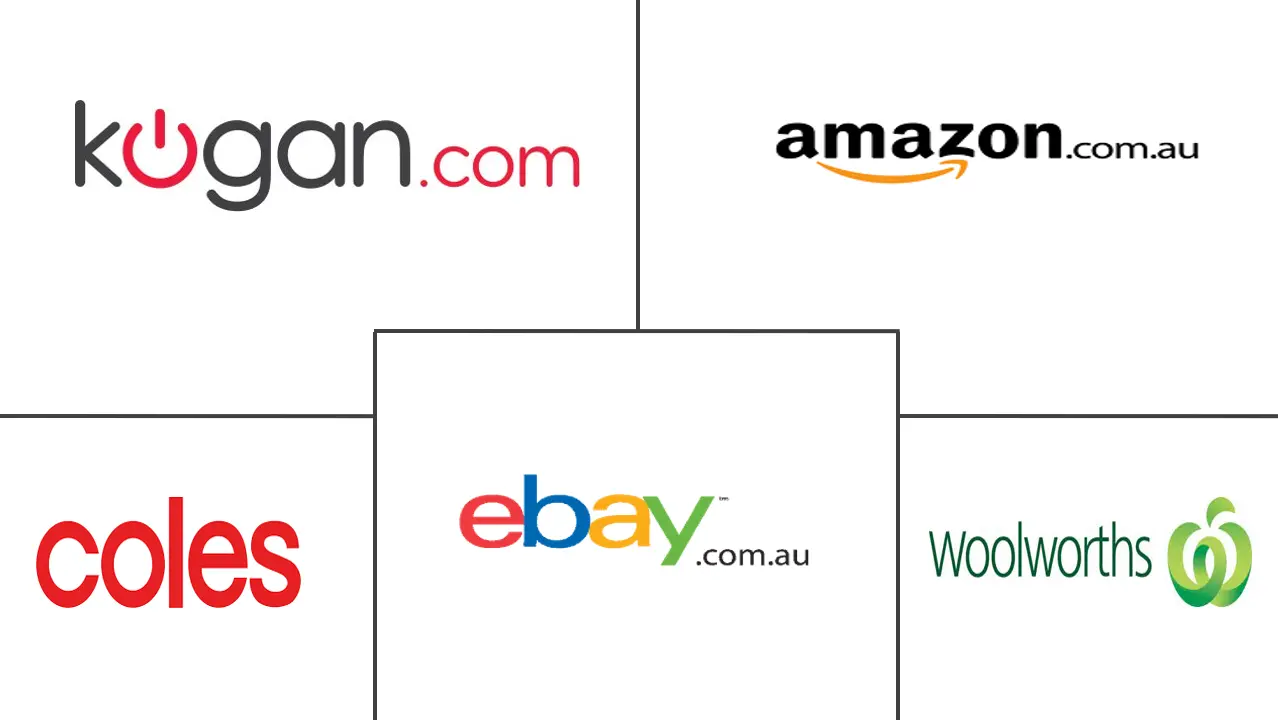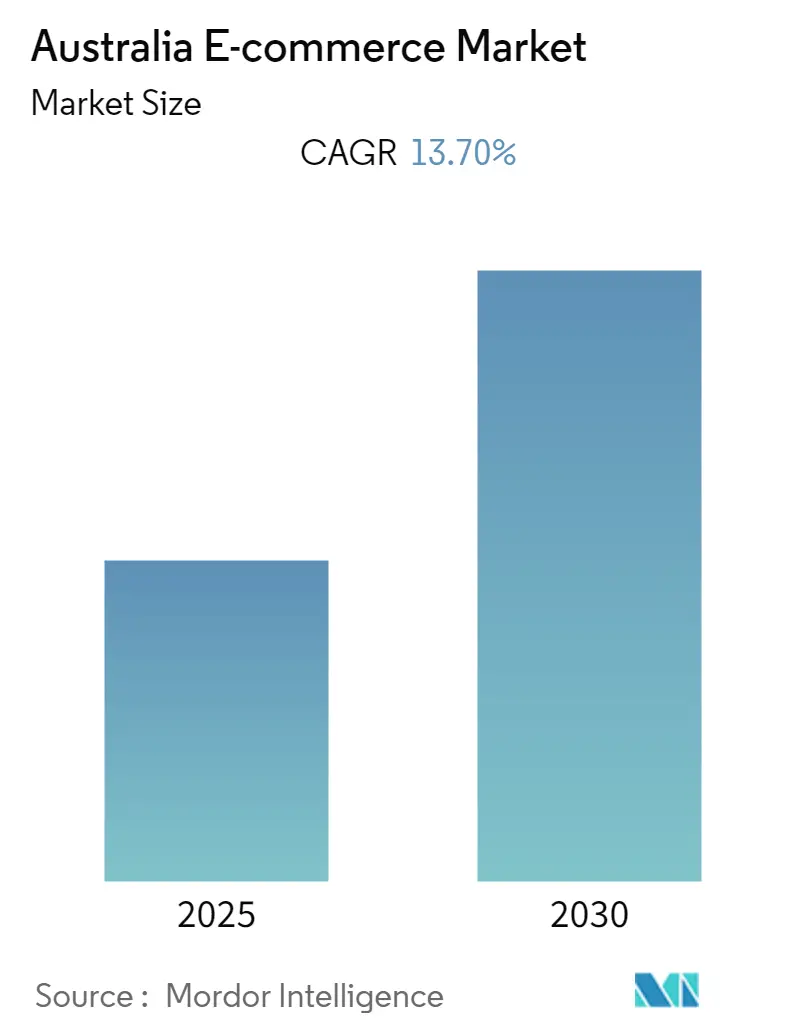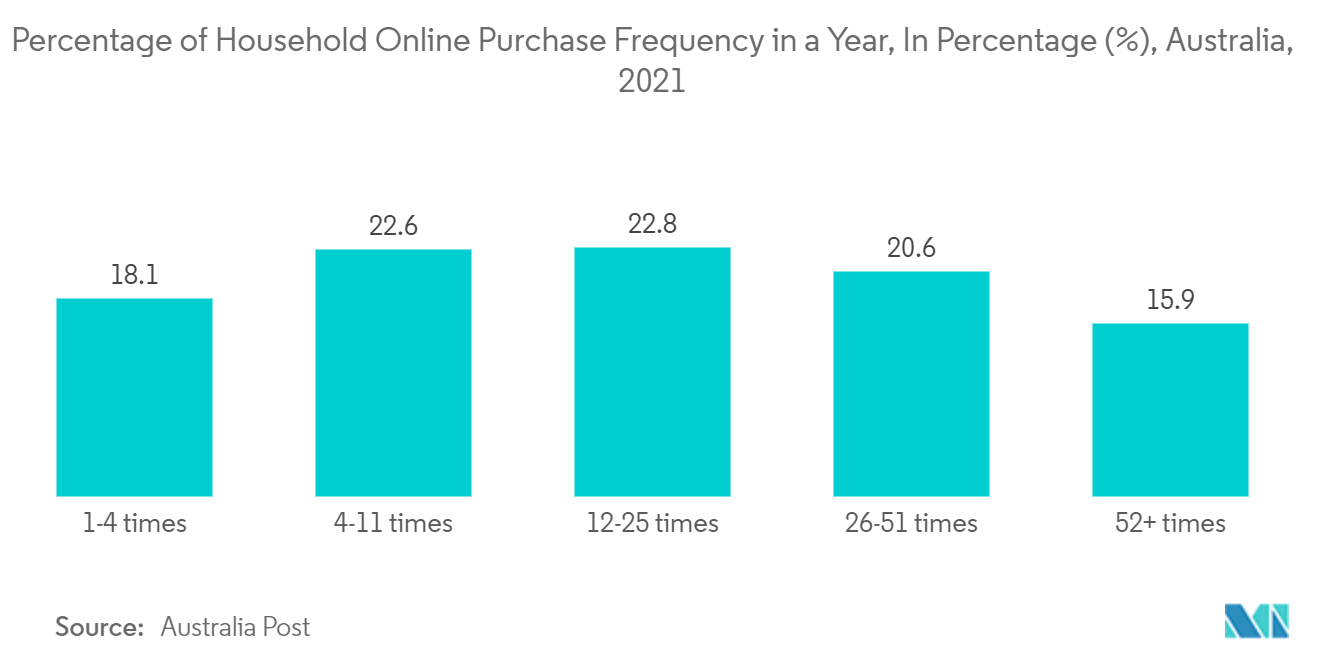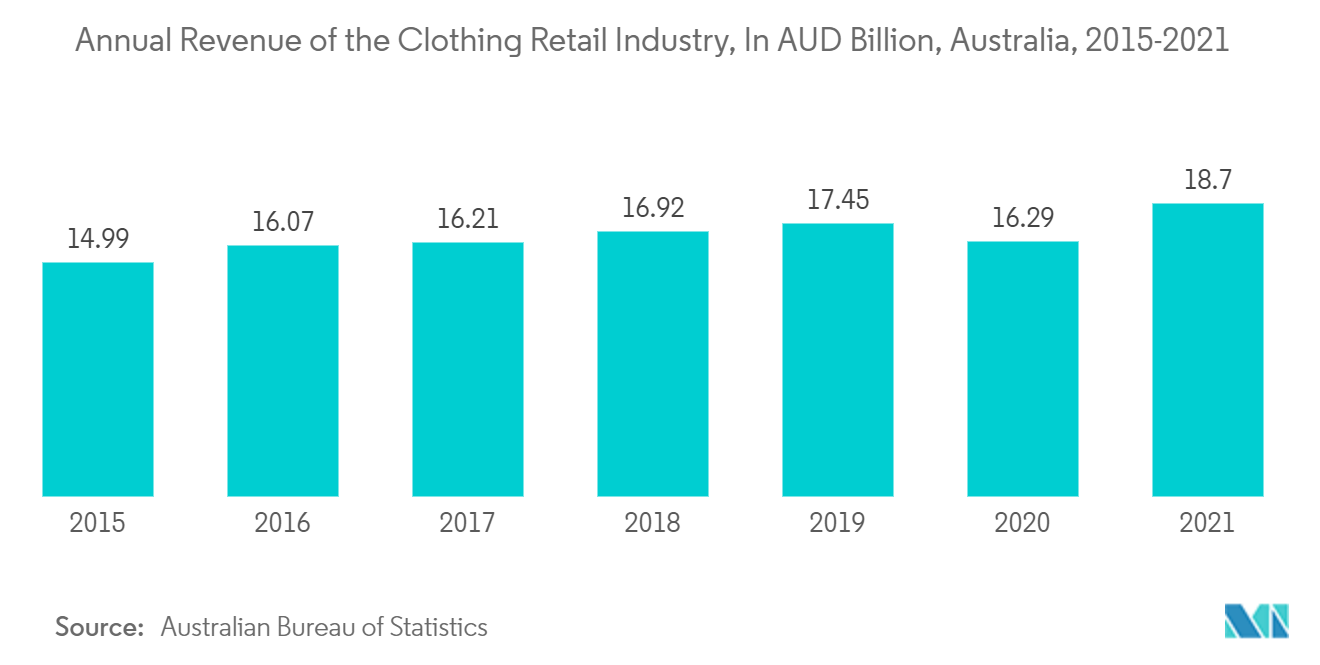Australia E-commerce Market Analysis
The Australia E-commerce Market is expected to register a CAGR of 13.7% during the forecast period.
- Australia is closer to where many of the global E-commerce leaders were pre-pandemic but still lags in purchase frequency. However, in the past few years, online spending and high-frequency buying have gained momentum in the region, which is expected to drive the market in the coming years.
- Moreover, consumer behavior and confidence in online purchasing are further driving the market in the region. E-commerce players in the region need to know every detail of their products and provide thorough information, supported by images, video, or virtual reality, to attract consumers. A variety of payment options, competitive shipping, and a range of delivery choices also provide customers with the flexibility they're seeking.
- According to Australia Post, 48.8% of all online payments are made via PayPal. Debit and credit cards account for 39.9% of online payments. The fastest-growing segment is the buy now pay later market, accounting for 6.7% of online transactions. The most well-known provider in this segment is AfterPay.
- Mobile commerce represents a major opportunity in the Australia E-commerce market. With mobile penetration close to 100%, mobile payments and purchasing are effective strategies for all E-commerce players. As per a recent report by PayPal, 26.4% of all E-commerce transactions occur via mobile phone, representing a 28.8% year-on-year increase and dwarfing transactions made over laptops and desktops, which have been shrinking over the last couple of years.
- E-commerce market players need to face the challenge of embedding sustainable practices that span the entire supply chain from product development right through to recycling options at the product's end of life. Many retailers are taking innovative approaches to this, including Designerex, a peer-to-peer designer clothing rental service, which is working to reduce the impact of fast fashion and facilitate a circular economy.
- The COVID-19 pandemic has brought a permanent shift in consumer buying behavior from in-store to online shopping, which has accelerated the E-commerce market in the region. The convenience brought by E-Commerce through home deliveries is expected to gain popularity, reach broader audiences, and increase sales for retailers in the years to come.
Australia E-commerce Market Trends
Rise in Purchase Frequency and Online Spending
- As reported by Australia Post, more Aussies are shopping online, with four-in-five households, 81% buying something online at some point during the year. Aussie shoppers spent an incredible USD 62.3 billion on online physical goods in 2021. Such high grossing in online sales indicates the country's rising interest in e-commerce.
- Furthermore, the report outlined the growth in spending on online physical goods was strong in 2021, at 23.4% year on year. This growth is primarily due to the new habits that have formed since the onset of the pandemic. Ongoing restrictions further strengthened this growth and encouraged shoppers to continue to buy online more frequently.
- Australia outperforms other countries in the number of consumers shopping online at least once a month. Furthermore, the rise in digital advertising by E-commerce companies through social media platforms is further increasing online spending and generating more product sales. With extensive shopping experience, technology-savvy shoppers are on-trend and knowledgeable. They are more likely to value efficiency and purchase from digital native retailers to get detailed product information and better customer service.
- As reported by Australia Post, as the popularity of online shopping continues to grow, so too does the number of online purchases made, with national year-on-year growth of 12.3% in 2021. An astounding 73.1% more purchases were made online in 2021 compared to 2019, demonstrating the significant change in shopper behavior over the past two years. Metro areas have experienced more restrictions due to the pandemic and, as a result, have seen slightly higher growth than regional. Households in inner regional areas contributed the most online purchase growth.
- All of the aforementioned factors are further expected to fuel the E-commerce market in the region over the forecast period.
Fashion and Apparel Segment is Expected to grow significantly
- The fashion and apparel segment is anticipated to witness significant growth. This growth is primarily governed by athleisure and footwear sales, with both of these sub-categories seeing a significant increase through July and August.
- Moreover, Cyber Week saw the most significant uplift in purchases of fashion and apparel products as people made a jump start on Christmas shopping and bagged bargains as they prepared for the busy party season. Apart from actively participating in sales events such as Black Friday and Prime Day, some online retailers adopted new technology to provide a better customer experience throughout the online shopping journey.
- Moreover, with high smartphone and internet penetration, brand-building over paid ads through social media platforms and short videos further attracts consumers to buy fashion and apparel products through online channels in the region.
- Consumers in the region have become increasingly conscious of how their online shopping habits impact the environment; they're beginning to seek out retailers taking steps to reduce their carbon footprint. Australian shoppers mainly prefer sustainable products in fashion, apparel, grocery, and beauty products. Furthermore, the region's younger generation demands a strong position on social and environmental issues such as sustainability. Many market players in the region started sustainable practices to gain new consumers and market share in the region, which is further expected to grow the E-commerce market.
- All mentioned factors are further expected to boost the E-commerce sales of fashion and apparel products over the forecast period.
Australia E-commerce Industry Overview
The Australia E-commerce market is fragmented in nature because of the high competitive rivalry among major market players. Major market players in Australia's E-commerce market are opting for expansion and partnerships as well as launching new products to gain market share. Some of the major market players in the region are eBay Australia Pty Ltd., Amazon Commercial Services Pty, Kogan.com, and Woolworths, among others.
- March 2022 - Amazon Australia announced the construction of its first sort center facility in the country commenced in Melbourne. The 15,600sqm operations facility will open this year at Goodman Group's new Amaroo Business Park in Craigieburn. The purpose-built sort center located in the north of Melbourne will enhance the company's delivery speed for customers across the country.
- March 2022 - Online retailer MyDeal launched a new global activities marketplace called Amazed.com in Australia. The new website will utilize MyDeal's proprietary marketplace technology and existing 1 million active customer base to offer a one-stop shopping experience for activities and experiences for locals. The company also plans to expand operations to New Zealand in the first half of the calendar year and then move to offshore markets like the UK and US.
Australia E-commerce Market Leaders
-
eBay Australia Pty Ltd
-
Amazon Commercial Services Pty Limited
-
Kogan.com
-
Woolworths
-
Coles
- *Disclaimer: Major Players sorted in no particular order
Australia E-commerce Market News
- April 2022 - Pinterest announced a strategic partnership with the E-commerce platform WooCommerce, which will enable WooCommerce's 3.6 million merchants the convert their product catalogs into Shoppable Pins on Pinterest. with this partnership, a new Pinterest app within WooCommerce would be launched, which will include various Pinterest shopping features such as tag deployment and catalog ingestion.
- May 2022 - Marketplacer announced the completion of a new holistic online marketplace for True Woo, offering a range of products and services targeted at individuals seeking ways to improve their wellbeing. The E-commerce platform says the marketplace it has created for True Woo features products and services designed to improve mental, emotional, physical, and spiritual health.
Australia E-commerce Industry Segmentation
E-commerce or electronic commerce refers to buying and selling goods and/or services via electronic channels such as the internet through smartphones, laptops, and tablets. E-commerce has emerged as a popular choice for purchasing goods and services online in Australia over the past few years.
The Australia E-commerce Market is Segmented into B2C E-commerce (Beauty and Personal Care, Consumer Electronics, Fashion and Apparel, Food and Beverage, Furniture and Home), and B2B E-commerce.
| By B2C E-commerce | Market Size (GMV) for the Period of 2017-2027 | ||
| Market Segmentation - by Application | Beauty and Personal Care | ||
| Consumer Electronics | |||
| Fashion and Apparel | |||
| Food and Beverages | |||
| Furniture and Home | |||
| Others (Toys, DIY, Media, etc.) | |||
| By B2B E-commerce | Market Size for the Period of 2017-2027 | ||
Australia E-commerce Market Research FAQs
What is the current Australia E-commerce Market size?
The Australia E-commerce Market is projected to register a CAGR of 13.7% during the forecast period (2025-2030)
Who are the key players in Australia E-commerce Market?
eBay Australia Pty Ltd, Amazon Commercial Services Pty Limited, Kogan.com, Woolworths and Coles are the major companies operating in the Australia E-commerce Market.
What years does this Australia E-commerce Market cover?
The report covers the Australia E-commerce Market historical market size for years: 2019, 2020, 2021, 2022, 2023 and 2024. The report also forecasts the Australia E-commerce Market size for years: 2025, 2026, 2027, 2028, 2029 and 2030.
Our Best Selling Reports
Australia E-commerce Industry Report
The Australia E-commerce market is experiencing significant growth, driven by various industry trends and market dynamics. The market segmentation includes B2C e-commerce sectors such as beauty and personal care, consumer electronics, fashion and apparel, food and beverage, and furniture and home, as well as B2B e-commerce. The industry analysis reveals that the market size is expanding, supported by robust industry growth and a positive industry outlook.
Market data indicates that the industry statistics reflect an upward trajectory in both market value and market growth. This is further corroborated by the market forecast, which predicts continued expansion in the coming years. The industry reports provide a comprehensive market overview, highlighting the contributions of market leaders and their influence on market trends.
The market segmentation analysis underscores the diversity within the e-commerce sector, with each segment contributing to the overall market value. Detailed industry research and industry reports offer valuable insights into market predictions and market review, ensuring stakeholders are well-informed about the industry's direction.
Industry information and industry research emphasize the importance of understanding market trends and growth rate to make informed business decisions. The industry sales figures and industry size metrics are crucial for evaluating market performance and identifying opportunities for growth.
Market outlook and market overview sections in the report highlight the strategic initiatives taken by market leaders to maintain their competitive edge. The report pdf provides an in-depth analysis of the market, including a report example that illustrates the key findings and industry statistics.
Research companies play a vital role in compiling and analyzing market data, offering a detailed market review and market predictions. Their analysis helps in understanding the market segmentation and the factors driving market growth.
In summary, the Australia E-commerce market is poised for substantial growth, with industry trends and market data supporting a favorable market outlook. The comprehensive industry analysis and market forecast provide a clear picture of the market's potential, making it an essential resource for stakeholders looking to navigate the evolving e-commerce landscape.







